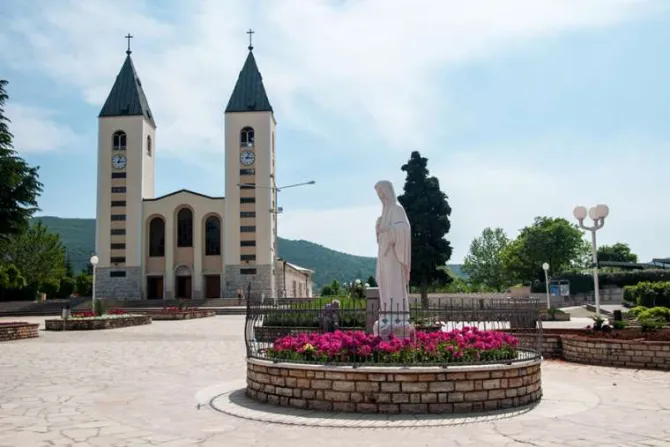Medjugorje, Bosnia and Herzegovina, May 12, 2019 / 06:46 am
Pope Francis has given the green light for Catholics to organize pilgrimages to Medjugorje, a site of alleged Marian apparitions, though the Church has not yet given a verdict on the apparitions' authenticity.
The pope's authorization of pilgrimages to the site is not to be understood as an "authentication" of the alleged apparitions, "which still require an examination by the Church," papal spokesman Alessandro Gisotti said in a statement May 12.
He added that anyone leading pilgrimages to the site should avoid creating "confusion or ambiguity under the doctrinal aspect," including priests who intend to celebrate Mass there.
The provision was made as an acknowledgment of the "abundant fruits of grace" that have come from Medjugorje and to promote those "good fruits." It is also part of the "particular pastoral attention" of Pope Francis to the place, Gisotti said.
The announcement of the papal authorization was made May 12 by the Vatican's apostolic visitor to the site, Archbishop Henryk Hoser, and Archbishop Luigi Pezzuto, apostolic nuncio to Bosnia and Herzegovina.
Hoser, retired archbishop of Warsaw-Prague, was appointed apostolic visitor to Medjugorje by Pope Francis in May 2018. His directive, which is of an undetermined length, is to oversee the pastoral needs at the site of the alleged Marian apparitions.
Hoser's appointment as apostolic visitor followed his service as papal envoy to the site in 2017.
In January 2014, a Vatican commission concluded a nearly four-year-long investigation on the doctrinal and disciplinary aspects of the Medjugorje apparitions, and submitted a document to the Congregation for the Doctrine of the Faith.
When the congregation has analyzed the commission's findings, it will finalize a document on the site, which will be submitted to the pope, who will make a final decision.
The alleged apparitions began June 24, 1981, when six children in Medjugorje, a town in what is now Bosnia and Herzegovina, began to experience phenomena which they have claimed to be apparitions of the Blessed Virgin Mary.
According to these six "seers," the apparitions contained a message of peace for the world, a call to conversion, prayer and fasting, as well as certain secrets surrounding events to be fulfilled in the future.
These apparitions are said to have continued almost daily since their first occurrence, with three of the original six children – who are now young adults – continuing to receive apparitions every afternoon because not all the "secrets" intended for them have been revealed.
Since their beginning, the alleged apparitions have been a source of both controversy and conversion, with many flocking to the city for pilgrimage and prayer, and some claiming to have experienced miracles at the site, while many others claim the visions are non-credible.
Pope Francis visited Bosnia and Herzegovina in June 2015 but declined to stop in Medjugorje during his trip. During his return flight to Rome, he indicated that the process of investigation in the apparitions was nearly complete.
On the return flight from a visit to the Marian shrine of Fatima in May 2017, the pope spoke about the final document of the Medjugorje commission, sometimes referred to as the "Ruini report," after the head of the commission, Cardinal Camillo Ruini, calling it "very, very good," and noting a distinction between the first Marian apparitions at Medjugorje and the later ones.
"The first apparitions, which were to children, the report more or less says that these need to continue being studied," he said, but as for "presumed current apparitions, the report has its doubts," the pope said.
(Story continues below)
On multiple occasions, the pope has said he is suspicious of the ongoing apparitions, "I prefer the Madonna as Mother, our Mother, and not a woman who's the head of an office, who every day sends a message at a certain hour. This is not the Mother of Jesus."



